| Scope of Consolidation |
| Yamato’s consolidated financial statements include the accounts of 17 consolidated subsidiaries and three affiliates accounted for by the equity method. | |||||
| Results of Operations |
| Operating Income For the fiscal year ended March 31, 2002, consolidated operating revenues rose 2.8% to ¥932,120 million (US$7,008.4 million). This was partly the result of the Company’s efforts to raise the quality of its existing products and expand transactions with new customers. Operating costs increased 2.8% to ¥861,775 million (US$6,479.5 million), and selling, general and administrative expenses advanced 2.7% to ¥17,156 million (US$129.0 million). Consequently, the ratio of total operating costs and expenses to operating revenues remained the same as the previous fiscal year at 94.3%, and operating income advanced 2.2% to ¥53,189 million (US$399.9 million). The consolidated operating income margin was 5.71%, compared with 5.74% in the previous term. By segment, efforts in the domestic transportation industry to improve competitiveness in the corporate market and streamline operations in all businesses, despite a continuing severe operating environment in ground and air transportation resulted in a 4.0% increase in operating revenues to ¥834,418 million (US$6,273.8 million). In the international transportation industry, although international transactions increased from small parcel business in the United States and logistics operations in Southeast Asia, the total amount of international freight originating in Japan was down. As a result, operating revenues from the international transportation industry decreased 9.4% to ¥61,189 million (US$460.1 million). In the information communications industry, despite the introduction of a comprehensive monitoring system for IDCs and the provision of seminars for e-business ventures, transfer of operations of our logistics center resulted in a 5.1% decline in operating revenues to ¥18,431 million (US$138.6 million). In the other industry, firm demand for packaging operations, strong sales of books through the Internet from PCs and mobile phones contributed to a rise in operating revenues of 3.6% to ¥18,082 million (US$136.0 million). |
|||||
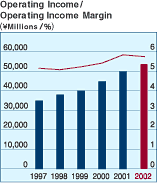 |
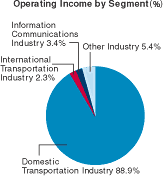 |
| Net Income Loss on sales of marketable and investment securities dropped 98.8% to ¥74 million (US$0.6 million), and interest and dividend income decreased 37.3% to ¥650 million (US$4.9 million). Other expenses-net of ¥3,284 million (US$24.7 million) was recorded, compared with ¥55,580 million in the previous term, largely due to reduction in obligations for retirement benefits. Owing to the above factors, the Company posted income before income taxes and minority interest of ¥49,905 million (US$375.2 million), as opposed to a loss before income taxes and minority interest of ¥3,554 million in the previous term. Income taxes of ¥22,217 million (US$167.0 million) resulted in net income of ¥27,512 million (US$206.9 million), compared with a net loss of ¥4,181 million in the previous term. Net income per share was ¥59.64 (US$0.45), compared with net loss per share of ¥9.25 in the previous term. Return on operating revenues was 2.95%. |
|||||
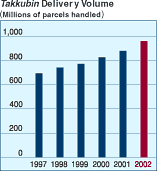 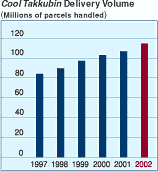 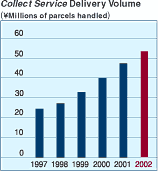 |
| Liquidity and Financial Resources |
| Cash Flows Net cash provided by operating activities totaled ¥69,724 million (US$524.2 million). Depreciation and amortization was ¥31,764 million (US$238.8 million), and increase in notes and accounts receivable was ¥152 million (US$1.1 million). Increase in liability for employees’ retirement benefits of ¥9,610 million (US$72.3 million) was added to income before income taxes and minority interest. Net cash used in investing activities was ¥46,468 million (US$349.4 million). The main uses of cash were purchases of property, plant and equipment of ¥39,435 million (US$296.5 million) and purchases of marketable and investment securities of ¥12,113 million (US$91.1 million). Net cash used in financing activities totaled ¥26,947 million (US$202.6 million). The principal uses of cash were repayments of long-term debt of ¥17,987 million (US$135.2 million) and dividends paid of ¥6,470 million (US$48.6 million). In aggregate, cash and cash equivalents, end of year, edged down to ¥155,303 million (US$1,167.7 million). |
|||||
| Financial Position Despite cash of ¥152,863 million (US$1,149.3 million), total current assets edged down 1.7% to ¥261,174 million (US$1,963.7 million). Total current liabilities increased 2.6% to ¥176,544 million (US$1,327.4 million) chiefly on the back of a 56.1% decline in current portion of long-term debt to ¥27,522 million (US$206.9 million). Net property, plant and equipment edged up 1.3% to ¥320,355 million (US$2,408.5 million). Total investments and other assets surged 10.1% to ¥97,430 million (US$732.6 million). Total assets increased 1.3% to ¥678,939 million (US$5,104.8 million), fueled by a ¥5,559 million jump in deferred tax assets to ¥29,709 million (US$223.4 million). Interest-bearing debt (the sum of short-term bank loans, the current portion of long-term debt and longterm debt) fell 17.7% to ¥95,046 million (US$714.6 million). The interest coverage ratio (operating income plus interest and dividend income divided by interest expense) improved 4.44 times to 24.99 times. Total shareholders’ equity edged up 6.0% to ¥364,806 million (US$2,742.9 million) and total assets increased 1.3% to ¥678,939 million (US$5,104.8 million). Shareholders’ equity as a percentage of total assets increased 2.37 percentage points to 53.73%. Return on average assets was 4.08% and return on average shareholders’ equity was 7.76%. |
|||||
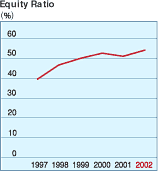 |
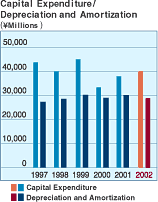 |
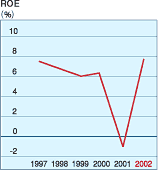 |